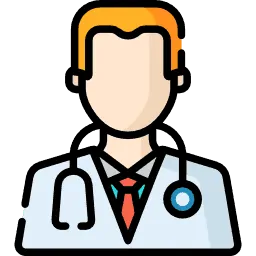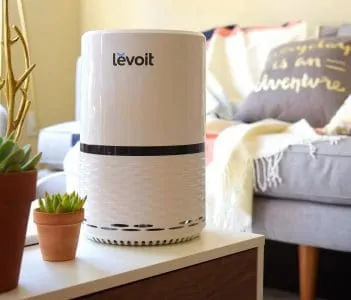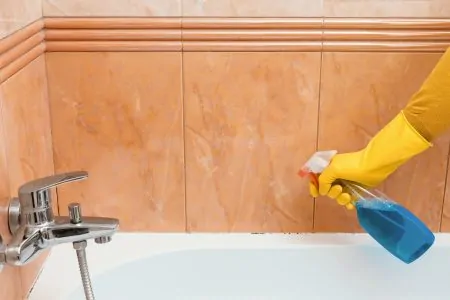If you suspect a white mold infestation in your house, please accept our sympathies. You must have a lot of questions about how it showed up and what this means for you.
Is it more than an unpleasant sight and smell? Is it as dangerous as black mold? What can you do to get rid of it as soon as possible?
Here we answer all the questions you may have if you suspect the growth of white mold in your home.
Key Takeaways
- White mold, caused by fungi, can grow on various organic materials and thrives in moist environments.
- It’s often confused with efflorescence and mildew, but white mold can cause health issues like allergies and asthma attacks.
- Proper identification and removal of white mold typically requires professional help to ensure the problem is resolved.
- Prevent mold growth by keeping surfaces dry, ventilating areas, using a dehumidifier, and conducting regular inspections.
What Does White Mold Look Like?
White mold caused by Sclerotinia sclerotiorum fungus is most often found on soybeans. However, it infects hundreds of plant species as well as other organic materials (1).
It can be panic-inducing to realize that white mold can also affect your home. Molds found indoors are caused by fungi too. Some of these include Alternaria, Aspergillus, Penicillium, Cladosporium, and Stachybotrys Chartarum.
Visual Signs of Mold
Out of the fungi causing mold, all but Stachybotrys are either white or green and can evolve in color.
If you keep bread in your home, you’ve likely seen white to green fuzzy coverage on its crust after a few days in the cupboard. This usually happens due to the cupboard humidity, and a fungal spore that made contact with the food.
Stachybotrys, also known as black mold, is considered toxic and should, with caution, be removed immediately. (2)
Where Does White Mold Grow?
As a fungus, white mold has its designated ideal environment for growth — water and moisture. As a rule of thumb, if mold is present, it means there’s improper water drainage somewhere in the building.
In nature, mold is crucial for rotting and soil enrichment. Indoors, however, it can pose a threat.
Common places you can find white mold in your home are:
- Wooden surfaces.
- Wallpaper.
- Cardboard.
- Carpets.
- Fabric.
- Plants.
- Food.
- Decaying leaves on plants.
What all of these have in common is that they’re all made of organic material. Note that mold spores travel by air. As a result, mold has a serious potential of damaging your home and your family’s health. (3)
White Mold Vs. Efflorescence
Homeowners often see efflorescence and inaccurately deem it to be white mold.
The confusion happens because the two are similar in color and texture. Unlike mold, which can grow anywhere in your home, efflorescence occurs mainly on concrete, bricks, and stone masonry. While mold grows and spreads, efflorescence doesn’t.
Efflorescence is a deposit of salts in crystalline form and is mostly seen on the exterior of new buildings. Rain normally takes care of washing it away if efflorescence is in its early stage (4).
In its advanced stage, also known as “lime spots,” it may cause perpetual moisture in the building. At this point, it should be removed with professional help as soon as possible (5).
Although it’s annoying and aesthetically unpleasant, efflorescence doesn’t pose health risks to the public.
White Mold vs. Mildew
Distinguishing between mold and mildew is harder, as they’re both white and fluffy and have a similar odor (6). Mildew is sometimes referred to as mold at an early stage. (7).
Both mildew and mold are caused by fungi, grow, spread, and pose the same risks. However, they still have some subtle differences that determine how they’re diagnosed and later removed.
Unlike mold, mildew grows on flat surfaces and develops in the same shape. It occurs mostly in the shower, kitchen, and other predominantly humid places in the home.
Mildew also changes its color; it can transform into yellow or brown. If untreated, it can spread and worsen any health impact, like an allergic reaction, on the people inhabiting the building.
Fortunately, mildew is relatively easy to treat. In fact, it can go away after being treated with bleach or vinegar, which every household tends to keep in stock. Mold, though, takes much more effort to remove.
Is White Mold Dangerous?
Yes, while not necessarily lethal, the white mold can be dangerous. It’s especially so to people suffering from asthma or those with a mold allergy. White mold can trigger asthma attacks and cause adverse allergic reactions. (8)
A fully-developed mold allergy is characterized as a reaction of the body to inhaling spores. If you have a weak immune system, you’re more at risk.
In most cases, mold in your home can, at the least, cause sensitivities, such as: (9)
- Wheezing.
- Sneezing.
- Red or itchy eyes.
- Stuffy nose.
- Cough, postnasal drip.
- Redness of the skin.
While some people can indeed live with mold, this is highly ill-advised. If any of the symptoms persist, consult your doctor.
How to Identify White Mold
The original issue with mold is that it can go unnoticed for a long time before you discover it.
It’s tempting to confirm the existence of white mold yourself, but your best bet is a professional inspection.
Some companies provide inspection as part of their mold-removing services. It’s always crucial to check their credentials and make an informed decision, as there are no certifications or regulations by the government on who is qualified to inspect mold (10).
While the government does not endorse mold-cleaning firms, companies that deal with water damage can help identify mold.
What About Test Kits?
The DIY route isn’t advisable when it comes to mold. Although some mold testing kits may be effective, no testing kit has been endorsed as a sufficient method of diagnosing mold. Therefore, it’s best if you follow it up with a professional inspection.
In any case, if you see signs or sense a damp, earthy or musty smell when entering a room and suspect that it may be white mold, seek out a professional.
Is It Possible to Kill Mold With UV Radiation?
Another common question raised by those battling mold in their homes is whether ultraviolet (UV) light has the power to kill mold.
The short answer is: only some of them. Ultraviolet germicidal irradiation (UVGI) cleaners — if properly designed — are effective in destroying indoor toxins, like viruses and bacteria. (11)
The usual domestic UVGI cleaners more commonly found will only work to a certain extent against mold. Plus, if people live in the house, they should never be your primary weapon.
Even if the cleaner of choice is indeed an effective and powerful one, a dead mold spore is not our main goal. These can still be dangerous as they will not stop producing allergic reactions.
The symptoms of asthma, for example, will not be reduced in any way if there are still dead spores around the house. So, this means UVGI cleaners, as effective as they might be in killing mold, are not enough by themselves.
Is Bleach a Good Alternative Against Mold?
The EPA discourages the repetitive use of bleach to clean up mold. But in some cases, it may be useful for the occasional clean.
As previously mentioned, it’s always important to consult a professional when dealing with a mold problem. They might advise the use of a biocide or chemical that kills organisms like mold (chlorine bleach is a good example of one).
The reason they would is an instance in which immune-compromised individuals are around. While using bleach, it’s essential to always ventilate and exhaust the air from the inside area to the outdoors.
Keep in mind that you shouldn’t mix ammonia with a chlorine bleach solution, as it can produce toxic fumes.
Remember that biocides are there to destroy living organisms. Although this sounds like a very aggressive measure of cleaning, it’s not particularly proper as routine practice for mold cleanup.
How to Clean up and Prevent White Mold
If you’re unfortunate enough to have white mold already, here are some tips for cleaning it up. If you’re lucky enough to not have white mold, let’s prevent it from infecting your lovely home.
Protecting Yourself
Protective equipment is recommended for cleaning moldy areas.
They include N-95 Respirators. You can buy these in most big hardware stores and online companies. You’ll also need normal rubber gloves and goggles (ones without any holes in them)(13).
Basic Clean-Up
There’s no need for any complicated homemade recipes here. Water and detergent, or bleach are enough to scrub off hard mold-covered surfaces.
Keep Surfaces Dry
In particular, all organic material surfaces in your home should be kept dry. This means quickly wiping up all spilled water or liquid from wooden floors. It also means repairing all plumbing leaks and related problems. Of course, you would also need to be careful when watering flowers with pots on the ground.
Washed carpet should be dried as soon as possible and not make contact with the floor. This is key, especially if the floor is made from organic materials.
Ventilate All Areas
Many of us know the smell of a moldy bathroom. So it’s important to ventilate all areas, especially the bathroom and the kitchen, where moisture is common. Ventilation is known to minimize moisture, which makes it an efficient tool for prevention.
Remember, mold can form and develop fast, so make sure you keep the door open or the ventilator on after each time you shower. The same goes for the kitchen, especially after meals that produce a lot of steam.
To maximize the effect on the whole house, keep the air in your home well-circulated. (14)
Dehumidify
Many people choose humidifiers for their home, usually during the winter, and to fight off congestion. Still, if you’re worried about mold in your house, a dehumidifier is more suitable.
The ideal humidity in your house is between 35 and 45 percent. If humidity rises to 50 percent, the risk of mold growth increases, so it’s best to tackle it as soon as possible with a dehumidifier. Having one on will keep humidity low throughout the house.
Regular Inspections
Remember, the earlier you discover the presence of mold, the faster you can react. You’ll also be able to stop the damage to both your home and your health in its tracks. (15)
For example, you can make mold and mildew inspection part of your Sunday cleaning routine and oversee all surfaces you dust. If you catch any signs of early growth, such as a smell or a fuzzy white coat, make sure to speak to a professional.
Think you need a professional? The EPA advises people to always choose those affiliated with a bigger professional organization.
FAQs
Breaking the Mold
White mold unifies several mold species — all caused by fungi. It grows and eats away at organic material, which risks the integrity of your home. It’s also a carrier of allergens and an annoyance to respiratory health, so it’s likely to induce diseases.
If it has never occurred to you to inspect the white mold in your house, now is a great time to do it. Catching it and stopping in its tracks is the safest way to ensure it doesn’t cause further damage.




















